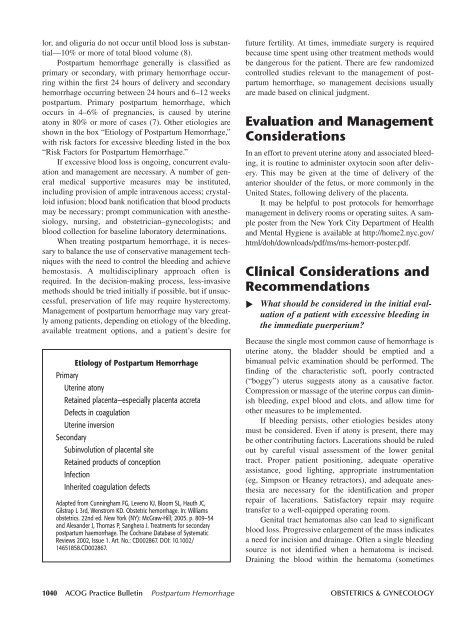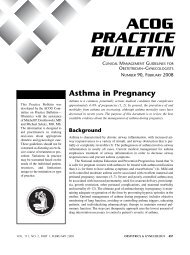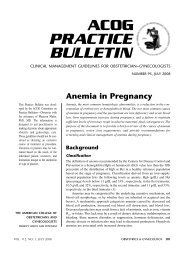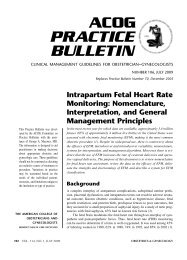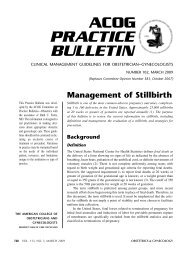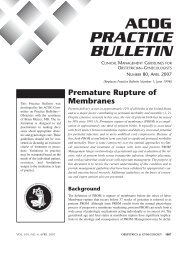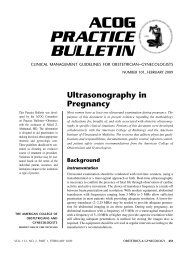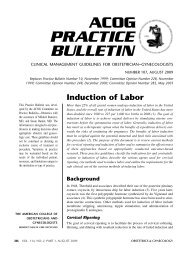ACOG Practice Bulletin No. 76: Postpartum Hemorrhage
ACOG Practice Bulletin No. 76: Postpartum Hemorrhage
ACOG Practice Bulletin No. 76: Postpartum Hemorrhage
Create successful ePaper yourself
Turn your PDF publications into a flip-book with our unique Google optimized e-Paper software.
▲<br />
lor, and oliguria do not occur until blood loss is substantial—10%<br />
or more of total blood volume (8).<br />
<strong>Postpartum</strong> hemorrhage generally is classified as<br />
primary or secondary, with primary hemorrhage occurring<br />
within the first 24 hours of delivery and secondary<br />
hemorrhage occurring between 24 hours and 6–12 weeks<br />
postpartum. Primary postpartum hemorrhage, which<br />
occurs in 4–6% of pregnancies, is caused by uterine<br />
atony in 80% or more of cases (7). Other etiologies are<br />
shown in the box “Etiology of <strong>Postpartum</strong> <strong>Hemorrhage</strong>,”<br />
with risk factors for excessive bleeding listed in the box<br />
“Risk Factors for <strong>Postpartum</strong> <strong>Hemorrhage</strong>.”<br />
If excessive blood loss is ongoing, concurrent evaluation<br />
and management are necessary. A number of general<br />
medical supportive measures may be instituted,<br />
including provision of ample intravenous access; crystalloid<br />
infusion; blood bank notification that blood products<br />
may be necessary; prompt communication with anesthesiology,<br />
nursing, and obstetrician–gynecologists; and<br />
blood collection for baseline laboratory determinations.<br />
When treating postpartum hemorrhage, it is necessary<br />
to balance the use of conservative management techniques<br />
with the need to control the bleeding and achieve<br />
hemostasis. A multidisciplinary approach often is<br />
required. In the decision-making process, less-invasive<br />
methods should be tried initially if possible, but if unsuccessful,<br />
preservation of life may require hysterectomy.<br />
Management of postpartum hemorrhage may vary greatly<br />
among patients, depending on etiology of the bleeding,<br />
available treatment options, and a patient’s desire for<br />
Etiology of <strong>Postpartum</strong> <strong>Hemorrhage</strong><br />
Primary<br />
Uterine atony<br />
Retained placenta—especially placenta accreta<br />
Defects in coagulation<br />
Uterine inversion<br />
Secondary<br />
Subinvolution of placental site<br />
Retained products of conception<br />
Infection<br />
Inherited coagulation defects<br />
Adapted from Cunningham FG, Leveno KJ, Bloom SL, Hauth JC,<br />
Gilstrap L 3rd, Wenstrom KD. Obstetric hemorrhage. In: Williams<br />
obstetrics. 22nd ed. New York (NY): McGraw-Hill; 2005. p. 809–54<br />
and Alexander J, Thomas P, Sanghera J. Treatments for secondary<br />
postpartum haemorrhage. The Cochrane Database of Systematic<br />
Reviews 2002, Issue 1. Art. <strong>No</strong>.: CD002867. DOI: 10.1002/<br />
14651858.CD002867.<br />
future fertility. At times, immediate surgery is required<br />
because time spent using other treatment methods would<br />
be dangerous for the patient. There are few randomized<br />
controlled studies relevant to the management of postpartum<br />
hemorrhage, so management decisions usually<br />
are made based on clinical judgment.<br />
Evaluation and Management<br />
Considerations<br />
In an effort to prevent uterine atony and associated bleeding,<br />
it is routine to administer oxytocin soon after delivery.<br />
This may be given at the time of delivery of the<br />
anterior shoulder of the fetus, or more commonly in the<br />
United States, following delivery of the placenta.<br />
It may be helpful to post protocols for hemorrhage<br />
management in delivery rooms or operating suites. A sample<br />
poster from the New York City Department of Health<br />
and Mental Hygiene is available at http://home2.nyc.gov/<br />
html/doh/downloads/pdf/ms/ms-hemorr-poster.pdf.<br />
Clinical Considerations and<br />
Recommendations<br />
What should be considered in the initial evaluation<br />
of a patient with excessive bleeding in<br />
the immediate puerperium<br />
Because the single most common cause of hemorrhage is<br />
uterine atony, the bladder should be emptied and a<br />
bimanual pelvic examination should be performed. The<br />
finding of the characteristic soft, poorly contracted<br />
(“boggy”) uterus suggests atony as a causative factor.<br />
Compression or massage of the uterine corpus can diminish<br />
bleeding, expel blood and clots, and allow time for<br />
other measures to be implemented.<br />
If bleeding persists, other etiologies besides atony<br />
must be considered. Even if atony is present, there may<br />
be other contributing factors. Lacerations should be ruled<br />
out by careful visual assessment of the lower genital<br />
tract. Proper patient positioning, adequate operative<br />
assistance, good lighting, appropriate instrumentation<br />
(eg, Simpson or Heaney retractors), and adequate anesthesia<br />
are necessary for the identification and proper<br />
repair of lacerations. Satisfactory repair may require<br />
transfer to a well-equipped operating room.<br />
Genital tract hematomas also can lead to significant<br />
blood loss. Progressive enlargement of the mass indicates<br />
a need for incision and drainage. Often a single bleeding<br />
source is not identified when a hematoma is incised.<br />
Draining the blood within the hematoma (sometimes<br />
1040 <strong>ACOG</strong> <strong>Practice</strong> <strong>Bulletin</strong> <strong>Postpartum</strong> <strong>Hemorrhage</strong> OBSTETRICS & GYNECOLOGY


